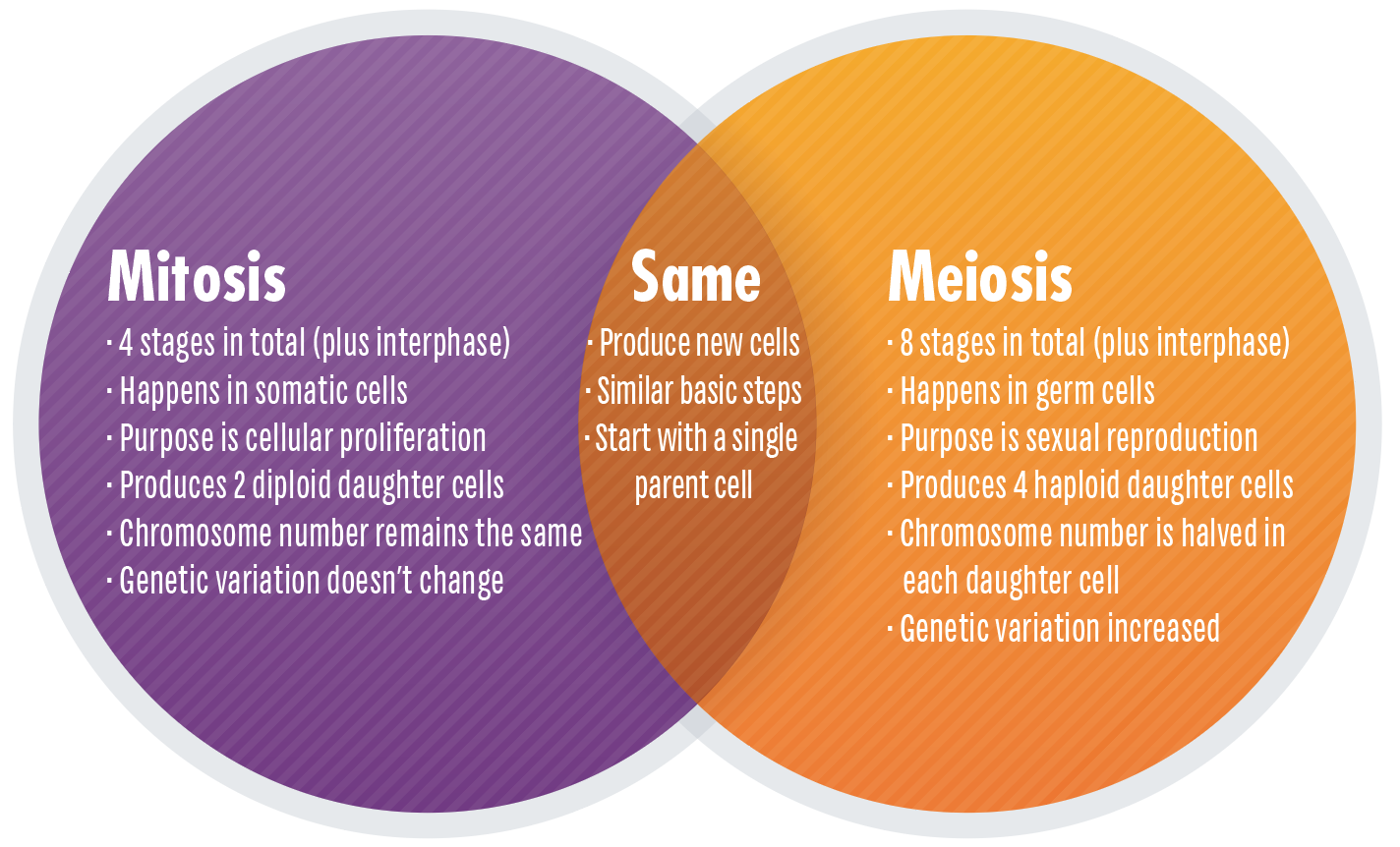Easy Ways to Remember Mitosis and Meiosis
Cell division occurs as a part of the "cell cycle". Just like your day has a routine from day to night, cells have routines of their own. The cell cycle is generally described as consisting of four main phases: G1, S phase, G2 and mitosis (or meiosis). Cells can also take a break from the grind of the cell cycle, in a state called G0 or senescence (note that some cells are permanently in G0). External growth factors can stimulate cells in G1 or G0 to proceed through the rest of the cycle, an example is Nerve Growth Factor (NGF), which promotes neuron growth. The restriction point is a special "point of no return" in G1 when cells no longer respond to removal of growth factors and will continue to progress to S phase no matter what. There are also internal signals that tell the cell to progress, these proteins are called cyclins and the cyclin that promotes mitosis is called cyclin B. S phase is especially important as this is the point at which the cell's entire genome is duplicated through the process of semi-conservative DNA replication.
The stages of mitosis are interphase, prophase, metaphase, anaphase and telophase, sometimes followed by cytokinesis. "Interphase" is a blanket term which describes all the stages before mitosis, that is: G1, S and G2 phases. The stages of meiosis are interphase, prophase I, metaphase I, anaphase I, telophase I, cytokinesis I, prophase II, metaphase II, anaphase II, telophase II, and finally cytokinesis II. See our detailed explanation below:
Another way to understand the progression of mitosis and meiosis is by thinking about what is happeningto the chromosomes, centrosomes, nuclear membrane and cell plasma membrane at each stage of the process. Here we show how to do this for mitosis, why not try to recreate this table for meiosis?
Mnemonics are also helpful, for example a useful mnemonic to remember the order of the steps in mitosis is "I Prefer Mating At Teatime" – Chamillionaire.
Mitosis vs. Meiosis Venn Diagram

Active research questions
The process of cell division is an intricate dance of molecular machinery that has fascinated researchers for hundreds of years. Advances in microscopy have had a huge impact on the field, from its humble beginnings observing metaphase chromosomes under the light microscope, to more sophisticated technologies today that can ask questions at the molecular level. Research into the cell cycle has also been highly rewarded, with the 2001 Nobel Prize in Physiology/Medicine being awarded to Tim Hunt, Paul Nurse and Leland Hartwell for their joint discovery of cyclins and cyclin-dependent kinases: the key regulators of the cell cycle [6]. However, despite our progress, many questions still remain.
How do cells promote faithful chromosome segregation in mitosis?
While there is only one way for mitosis to go right, there are many ways for it to go wrong. For example, in early mitosis, if there are incorrect contacts between microtubules and chromosomes, chromosomes can become misaligned, which can lead to incorrect segregation of sister chromatids. In late mitosis, how is the cell certain that the time is right to perform cytokinesis? The chromosome passenger complex (CPC) is a molecular guardian angel that acts at many stages of mitosis to safeguard the fidelity of the process. At the start of mitosis, the CPC localises all over the chromosomes and acts to modify chromatin, during mitosis it moves to the chromosome centromeres to prevent incorrect microtubule attachments and before cytokinesis the CPC finds its way to the central spindle. Therefore, a question of ongoing research is how does the CPC elegantly re-localise throughout mitosis to save the day?
Further reading
•Vader, G., Medema, R. H., & Lens, S. M. (2006). The chromosomal passenger complex: guiding Aurora-B through mitosis. The Journal of cell biology, 173(6), 833-837.
•Kabeche, L., Nguyen, H. D., Buisson, R., & Zou, L. (2018). A mitosis-specific and R loop–driven ATR pathway promotes faithful chromosome segregation. Science, 359(6371), 108-114.
How are homologous chromosomes held together, and then separated in meiosis I?
You might remember from above that it is the protein cohesin that holds together sister chromatids in metaphase of mitosis and metaphase II of meiosis. However, in meiosis I homologous chromosomes must be held together in metaphase I, before these ties are swiftly broken during anaphase I. This feat is performed by a miraculous cellular zipper called the synaptonemal complex (SC). This zipper must be strong enough to hold chromosomes together, but it must also be disassembled equally efficiently, otherwise homologous chromosomes will not accurately segregate in anaphase I, leading to a potentially disastrous genetic inequality in the daughter cells. How exactly this zipper disassembles is a hot topic of research.
Further reading
•Argunhan, B., Tsubouchi, T., & Tsubouchi, H. (2018). Polo is not solo in meiosis. Cell Cycle, 17(3), 273-274.
•Gao, J., & Colaiácovo, M. P. (2017). Zipping and unzipping: protein modifications regulating synaptonemal complex dynamics. Trends in Genetics.
References
1) Bennett, M. D. (1977). The time and duration of meiosis. Phil. Trans. R. Soc. Lond. B, 277(955), 201-226.
2) Jett, J. H. (2015). How long does it take a cell to divide? Cytometry Part A, 87(5), 383-384.
3) Brewer, B. J., Chlebowicz-Sledziewska, E., & Fangman, W. L. (1984). Cell cycle phases in the unequal mother/daughter cell cycles of Saccharomyces cerevisiae. Molecular and cellular biology, 4(11), 2529-2531.
4) Clift, D., & Schuh, M. (2013). Restarting life: fertilization and the transition from meiosis to mitosis. Nature reviews Molecular cell biology, 14(9), 549.
5) Paweletz, N. (2001). Walther Flemming: pioneer of mitosis research. Nature Reviews Molecular Cell Biology, 2(1), 72.
6) Nurse, P. M. (2002). Nobel Lecture: Cyclin dependent kinases and cell cycle control. Bioscience reports, 22(5), 487-499.
Source: https://www.technologynetworks.com/cell-science/articles/mitosis-vs-meiosis-312017
0 Response to "Easy Ways to Remember Mitosis and Meiosis"
Post a Comment